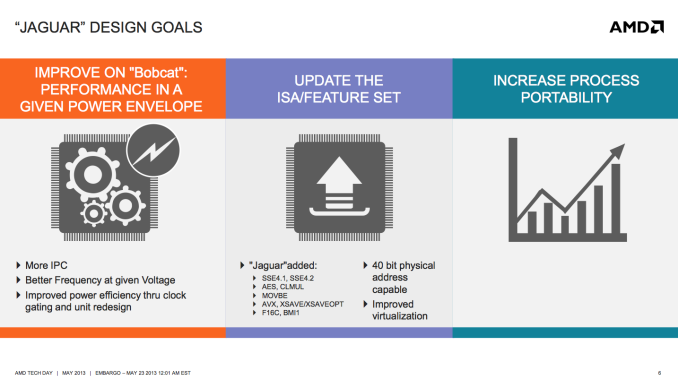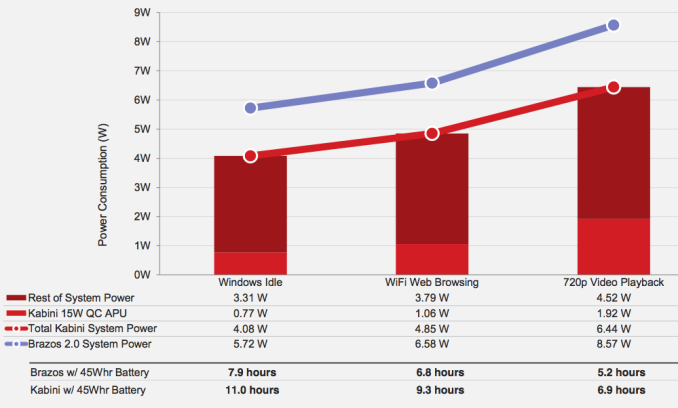AMD’s Jaguar Architecture: The CPU Powering Xbox One, PlayStation 4, Kabini & Temash
by Anand Lal Shimpi on May 23, 2013 12:00 AM ESTFinal Words
Bobcat was a turning point for AMD. The easily synthesized, low cost CPU design was found in the nearly 50 million Brazos systems AMD sold since its introduction. Jaguar improves upon Bobcat in a major way. The move to 28nm helps drive power even lower, which will finally get AMD into tablet designs with Temash. Despite being lower power, Jaguar also manages to increase performance appreciably over Bobcat. AMD claims up to a 22% increase in IPC compared to Bobcat. Combine the IPC gains with a more multi-core friendly design and Jaguar based APUs should be appreciably faster than their predecessors.
Quite possibly one of the only real weaknesses with Jaguar is the lack of aggressive turbo modes in any of the shipping implementations of the design. It appears that the first implementations of Jaguar were under time constraints, leaving many features (including improved thermal monitoring/management and turbo boost) on the cutting room floor. Kabini and Temash seem ripe for a mid-cycle update enabling turbo across more parts, which could do wonders for single threaded performance.
The Jaguar power story actually looks very good, it's just hampered by traditional PC legacy. None of the launch APUs here support the low power IOs necessary to drive platform power down even further. AMD is getting very close though. Jaguar's core power is easily sub-2W for lightweight tablet tasks, the rest of the platform (excluding display) drives it up to 4 - 7W. AMD definitely has the right building blocks to go after truly low power tablets in a major way, should it have the resources and bandwidth to do so.
In its cost and power band, Jaguar is presently without competition. Intel’s current 32nm Saltwell Atom core is outdated, and nothing from ARM is quick enough. It’s no wonder that both Microsoft and Sony elected to use Jaguar as the base for their next-generation console SoCs, there simply isn’t a better option today. As Intel transitions to its 22nm Silvermont architecture however Jaguar will finally get some competition. For the next few months though, AMD will enjoy a position it hasn’t had in years: a CPU performance advantage.
I can’t stress enough how important it is that AMD continues to focus on driving the single threaded performance of its cat-line of cores. Second chances are rare in this business, but that’s exactly what AMD has been offered with the rise of good enough computing. Jaguar vs. Atom is the best CPU story AMD has had in years. Regular updates to the architecture coupled with solid execution are necessary to ensure that history doesn’t repeat itself in a new segment of AMD’s business.
Long term, I can’t help but wonder what Bobcat’s success will do to shape AMD’s future microarchitecture decisions. I’m not sure what Jim Keller’s SoC project is, but I’m wondering if the days of really big cores might be over. I don’t know that really small cores are the answer either, but perhaps something in between...












78 Comments
View All Comments
Wolfpup - Wednesday, June 12, 2013 - link
Ironically when I see an Intel sticker on a tablet (unless it's a Core i part), I avoid it like the plague. Bobcat would have been perfect for tablets, and a BIG selling point.Wolfpup - Wednesday, June 12, 2013 - link
Yeah, I really have no interest in an Atom tablet, partially even just because of the horrible video.I've got an 11.6" AMD c50 (lowest end Bobcat) based notebook, and while it's slow, it's still impressive how it runs anything, and in a pinch can even function as a main PC. AMD's got an even lower power Bobcat part with the exact same performance for tablets, but I don't know of shipping computers that used it, and it really would have been perfect. These new ones of course will be even better.
I wonder if the companies building these understand that using AMD would be a selling point... I see "Atom" and my eyes glaze over....
codedivine - Thursday, May 23, 2013 - link
4 DP FMAs per 16 cycles? Why even bother putting them in :|Tuna-Fish - Thursday, May 23, 2013 - link
Because it's expected by the spec, and some compute loads use it for very rarely used things.Exophase - Thursday, May 23, 2013 - link
"I should point out that ARM is increasingly looking like the odd-man-out here, with both Jaguar and Intel’s Silvermont retaining the dual-issue design of their predecessors."It's not just ARM, it's three different current gen ARM cores.. if you're going to pose it as ISA shouldn't it then just be ARM vs x86 and not ARM vs Silvermont and Jaguar?
Besides, MIPS is 3-way in its CPUs targeting this power budget too (proAptiv), and so is PowerPC (e600 for instance). The reason why Silvermont and Jaguar is 2-way is really undeniable: x86 decoders are substantially more expensive than those for any of these ISAs, even Thumb-2. There's some validity to the argument that x86 instructions are more powerful (after first negating where they aren't - most critically, lack of three-way addressing adds a lot of extra move instructions for non-AVX processors) but nowhere close to 50% more powerful.
lmcd - Thursday, May 23, 2013 - link
Isn't Qualcomm Krait 2-way?Exophase - Thursday, May 23, 2013 - link
Qualcomm hasn't said an awful lot about the internals of the uarch but several sources report 3-way decode and I haven't seen any say 2-way. It's possible that isn't fully symmetric or limited in some other way, we don't really know.Krysto - Friday, May 24, 2013 - link
Pretty sure it's 3-way.tiquio - Thursday, May 23, 2013 - link
I don't really understand the point about unique macros. What are macros in reference to CPU architecture.quasi_accurate - Thursday, May 23, 2013 - link
Don't worry, I had no idea either until I started working in the industry :) It just means custom circuits that are hand crafted by a human. This is as opposed to "synthesis", in which the RTL code (written in a hardware description language such as Verilog) are "synthesized" by design software into circuits.